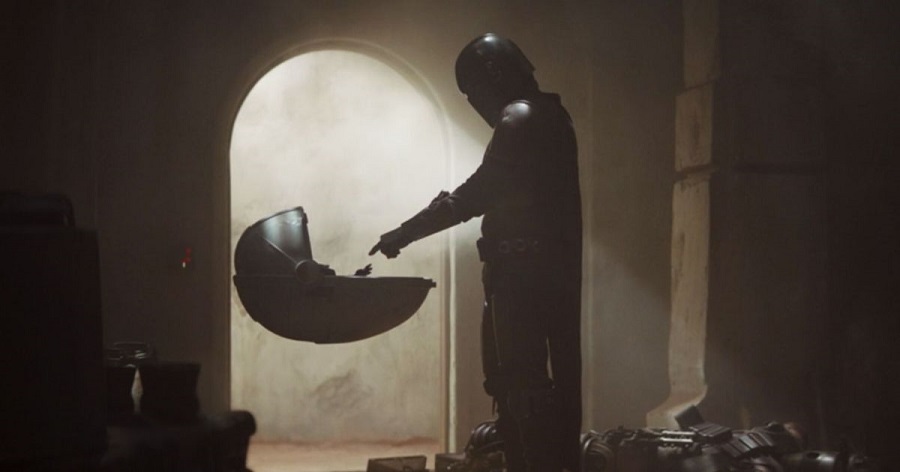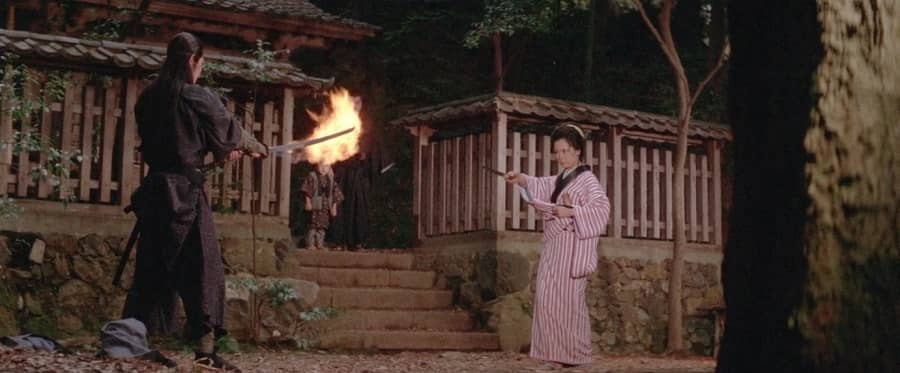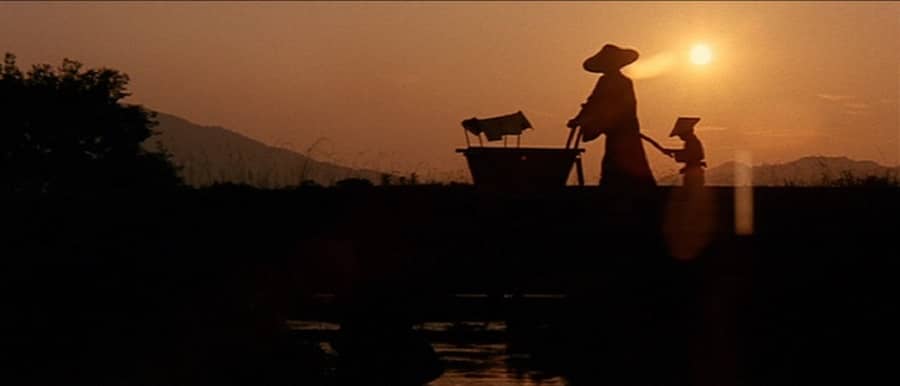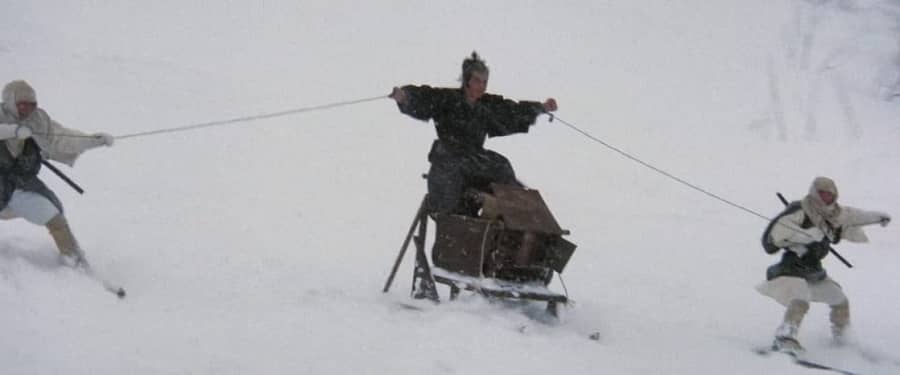Ellsworth’s Cinema of Swords: Lone Wolf and Cub Part 2
The Mandalorian
We’ve already gone into the origins of the Lone Wolf and Cub films in the manga series by Kazuo Koike and Goseki Kojima, so this week let’s look at its influence on later productions, particularly the Star Wars series The Mandalorian. I’m far from the first person to point out the connections between the two, but as they show the continuing relevance of Lone Wolf and Cub even fifty years later, I think it’s worthwhile to revisit them.
To state the obvious, The Mandalorian draws most of its inspiration from the Western genre, especially the Italian variety known as Spaghetti Westerns, and of course from the Star Wars saga itself. But the Lone Wolf influence is strong: the visual archetype of the solo martial artist fighting off waves of enemies with a young son by his side or in his arms is powerful, and was adopted in whole.
But there are thematic similarities as well: when Itto Ogami, the Shogunate executioner who lives by a rigorous warrior code, is betrayed by a rival clan, his wife slain and his son threatened, Ogami breaks the rules, refusing to commit seppuku and taking his son with him into an outlaw career as an assassin for hire. The Mandalorian has a tribal warrior code and belongs to a guild of bounty hunters with strict rules — but when the child who has adopted his heart is threatened with death, he abandons his guild and its rules and goes on the run, his new son by his side.
As in the Lone Wolf films, the bond between father and son is virtually wordless, but we are often shown the world, not through the slits of the Mandalorian’s helmet, but through the wide and innocent eyes of his adopted child. And like Itto Ogami’s son Daigoro, little Grogu is not as helpless as he seems.
Lone Wolf and Cub 4: Baby Cart in Peril (or Slashing Blades of Carnage)
Rating: ****
Origin: Japan, 1972
Director: Buichi Saito
Source: Criterion Blu-ray
With this entry the series changes, as star Tomisaburo Wakayama takes over the producer role from his brother Shintaro Katsu, bringing in a new director, Buichi Saito, and ratcheting up the sensationalism with more nudity and gore. There’s also an increased wuxia influence, with Itto Ogami and his ninja opponents making ten-foot aerial leaps.
And notably, where the first three films were about the Lone Wolf, this film belongs as much to the Cub, as Daigoro Ogami becomes more of a partner in the action and less of a mere observer. The story also reverts to the more complex structure of the first film, employing lots of flashbacks, though they’re always strongly cued and easy to follow.
Itto (Wakayama) is hired by the Owari clan to kill a renegade female assassin named Yuki (Michie Azuma) who fights topless, her torso covered in startling tattoos the better to distract her male opponents. The Lone Wolf sets out on his mission, but during a town festival, young Daigoro chases after some street clowns, gets lost, and wanders off into the country, where he meets a grim swordsman at a temple. The swordsman is struck by Daigoro’s “Death Life Eyes,” and follows him on his wanderings, astounded by his survival skills, until Daigoro finds his father. Itto recognizes the swordsman as Gunbei Yagyu (Yoichi Hayashi), who once competed on behalf of the Yagyu clan against Itto for the position of Shogunate executioner, losing out because during the bout he carelessly pointed his sword at the Shogun. The Yagyu clan faked his subsequent ritual suicide and then sent the disgraced Gunbei into internal exile. He demands a rematch with Itto but the Lone Wolf refuses, saying, “It’s no use killing a dead man.”
Itto knows that before Yuki became an Owari “sword mistress” she was a street performer of the Gomune guild, so he visits their secluded refuge to speak to Jindayu, the boss of the Gomune, who reveals that Yuki is his daughter but tells Itto to seek her at a remote hot springs resort. Yuki, meditating at the springs, reveals via flashback her reasons for becoming a tattooed assassin: she had been raped by Kozuka, an Owari swordsman-illusionist with a flaming sword and a mesmerizing gaze. As Itto arrives, she kills another half-dozen Owari samurai sent to slay her, taking their topknots to send back to their clan to goad them. Itto disapproves: shamed in that way, a samurai’s entire family is banished from the clan, but her taunts work, as the Owari are finally provoked into sending Kozuka to kill her. This time, Yuki kills the illusionist, and then Itto reluctantly kills Yuki, giving her the best death he can.
But the vengeful Yagyu clan are now hot on Itto’s trail, and their villainous leader Retsudo (Tatsuo Endo, who played several vile yakuza bosses in the Zatoichi series) misleads the Owari daimyo, telling him Itto had joined with Yuki to kill the Owari samurai. Incensed, the daimyo calls out his troops, and there’s an exciting climax in which Itto must face the Owari clan as well as the killers of the Yagyu and their allies, the Torugawa ninjas. There’s no need to spill all the details, but some of the stunts in this extended final mêlée are spectacular, and the body count is very high indeed.
Lone Wolf and Cub 5: Baby Cart in the Land of Demons (or Five Fistfuls of Gold)
Rating: *****
Origin: Japan, 1973
Director: Kenji Misumi
Source: Criterion Blu-ray
If this is the best of the Lone Wolf and Cub films, it’s probably because it has the most interesting and thought-provoking story, adapted once again from his manga series by writer Kazuo Koike. Itto Ogami (Tomisaburo Wakayama) is hired by different elements of the Kuroda clan, not once, but twice!
A series of five Kuroda samurai test themselves to destruction against Itto, each giving him one-fifth of the payment for an assassination and one-fifth of the “secrets and reasons” behind it: the Kuroda lord has substituted his mistress’s young daughter for his legitimate son, and in atonement given a letter confessing his actions to a holy Buddhist priest — but the priest, Abbot Jikei (Hideji Otaki) is actually a secret ninja boss for the Yagyu clan and plans to turn over the letter to the Shogunate, which will mean the end of the Kuroda. Itto agrees to kill Jikei and recover the letter, and is then hired by another Kuroda agent, a woman called Ghost-Fire (Michiyo Okusu), to kill the Kuroda lord, his mistress, and daughter, so the legitimate prince can inherit the lordship.
Pretty cool, but it gets even better. During a town festival, Itto leaves his son Daigoro in his baby cart and goes to Abbot Jikei’s temple to kill him, but is stunned to find that he can’t do it. Jikei tells him why: the abbot has “merged with nothingness” and Itto won’t be able to slay him until he perfects the assassin’s art and passes through the “gateless barrier.” Disconcerted for the first time in his career and unsure how to proceed, Itto returns to the baby cart, only to find that Daigoro is gone, having followed some excited children to the festival. In the town, we follow the larcenous activities of a charming female pickpocket called Quick-Change O-yo (Tomomi Sato), who is being pursued by a master detective from Edo.
With the detective hot on her heels, O-yo gives a stolen wallet to Daigoro to hold and has him promise to tell no one where he got it. The detective spots Daigoro with the wallet, arrests him, and takes him to a public platform where he threatens to flog the toddler unless O-yo turns herself in. O-yo surrenders, but when the detective asks Daigoro to identify her as the one who gave him the wallet, he refuses, and steadfastly goes on refusing even when the detective flogs him hard. Meanwhile, Itto, watching silently from the crowd, sees in his three-year-old son the determination he needs to pass the gateless barrier and become the perfect assassin.
The rest of the film is pretty much nonstop action. In an amazing scene that shouldn’t be spoiled, Itto assassinates Jikei and recovers the scroll. (When the abbot realizes he’s about to be murdered, he says quietly, “Is it not good, he who perfects his path?”) The Yagyu ninja and the Kuroda Mask-Men are no match for Itto, and the Lone Wolf completes his second assassination task as well before his final meeting with Ghost-Fire. For this movie, Kenji Misumi returns to the director’s chair for his next-to-last film before his untimely death at the age of 54. He, too, had perfected his art.
Lone Wolf and Cub 6, White Heaven in Hell
Rating: ****
Origin: Japan, 1974
Director: Yoshiyuki Kuroda
Source: Criterion Blu-ray
By late 1973 it looked like the Lone Wolf and Cub movie series was over. Making five movies in quick succession, they had run through adaptations of the full manga series published since 1970 and were out of stories to tell. Lead director Kenji Misumi felt that, visually, the series had said all it had to say, and declined to sign on for another entry.
But star and now producer Tomisaburo Wakayama wasn’t ready to give up. Reputedly disappointed at not getting the lead role in the Lone Wolf and Cub TV series, but with enough funding for a sixth film, Wakayama decided to go big and make the wild, over-the-top movie he’d been dreaming of. He hired Tsutomu Nakamura to write an all-new script to meet his needs, and Yoshiyuki Kuroda, known for his yokai fantasy-horror films, to direct. And the series went out with a bang.
The previous films had mostly stuck to the structure of the Lone Wolf and Cub taking an assassination job and then somehow completing it despite interference from Itto Ogami’s nemesis, the Yagyu clan. This film dropped that conceit, devoting itself to a final showdown between Itto and the Yagyus, led by the relentless Lord Retsudo (Minoru Ohki).
Retsudo is called on the carpet by the Shogun because the Yagyus’ repeated failure to capture or kill Itto Ogami is a public embarrassment for the government. Though in previous encounters Itto had slain Retsudo’s three sons, he begs for more time from the Shogunate because he still has one child, his daughter Kaori (Junko Hitomi), who also has been trained as a formidable martial artist. Kaori, who fights with throwing knives that she juggles hypnotically to confuse her opponents, sets out to get at Itto through his son, Daigoro. But the boy proves as fearless as his father, Kaori fails, and falls.
Now things get good and strange. Wait, says Retsudo, I still have an illegitimate son, Hyoei (Isao Kimura), who’s been adopted by the Tsuchigumo, a pariah clan of demon-worshipping weirdos who skulk in the remote mountains. Hyoei receives his father with scorn but agrees to kill Itto Ogami, not to do dad a favor, but to show him up for a failure.
Hyoei’s chief weapon is to be three Tsuchigumo warriors who were buried alive and have been resurrected with creepy powers. These undead samurai can burrow through the ground like moles and like to slaughter innocents wholesale to strike terror into the hearts of their enemies. Itto and Daigoro are visibly shaken by the depredations of the three Tsuchigumo, and the former executioner realizes he must find a new strategy to deal with them.
So Itto puts skis on Daigoro’s baby cart and retreats into the snowy north, where the Tsuchigumo will be out of their comfort zone. And indeed, burrowing through snow is more difficult than moling it through the warm loam of central Japan, and the half-frozen Tsuchigumo are slowed just enough that Itto, with the help of Daigoro in his deadly baby sled, is able to take them down.
However, Lord Retsudo, desperate, has followed Itto into the north with all his remaining warriors and ninjas, now mounted on skis and sleds, and there’s a final mass confrontation on the snowy mountain slopes. This climactic fight in the deep snow took six weeks to film, but Wakayama persisted and got the epic conclusion to the series he wanted. There’s nothing else like it.
Where can I watch these movies? I’m glad you asked! Many movies and TV shows are available on disk in DVD or Blu-ray formats, but nowadays we live in a new world of streaming services, more every month it seems. However, it can be hard to find what content will stream in your location, since the market is evolving and global services are a patchwork quilt of rights and availability. I recommend JustWatch.com, a search engine that scans streaming services to find the title of your choice. Give it a try. And if you have a better alternative, let us know.
Previous installments in the Cinema of Swords include:
Flynn’s Last Flourishes
Mighty Colossi And Hydrae
Rejecting Bushido (Part One)
Pirates — Italian Style
The Year of Camelot and Scarecrows
Rejecting Bushido (Part Two)
The Fall of the Hollywood Epic
Cheh’s On Second
En Garde, Old Boy
More Hammer Historicals
Zatoichi’s Finest
A Little History
Lone Wolf and Cub, Part I
Premium Peplum
The Book Was Better
Shogunate’s End
Peak Musketeers
LAWRENCE ELLSWORTH is deep in his current mega-project, editing and translating new, contemporary English editions of all the works in Alexandre Dumas’s Musketeers Cycle, with the fifth volume, Between Two Kings, coming in July from Pegasus Books in the US and UK. His website is Swashbucklingadventure.net.
Ellsworth’s secret identity is game designer LAWRENCE SCHICK, who’s been designing role-playing games since the 1970s. He now lives in Dublin, Ireland, where he’s writing Dungeons & Dragons scenarios for Larian Studios’ Baldur’s Gate 3.




Great finishing article to the original Baby Cart series, Lawrence. I always feel whenever I watch the 6th film that they took inspiration from and provided inspiration to the James Bond film series with the movies that had Lazenby and Moore engaging in big skiing action fights in Switzerland.
I would so like to be in for the distributor discussion of how to title Lone Wolf and Cub 4: “I don’t know, want to go with Baby Cart in Peril?”, “No, it needs a bit more … how about Slashing Blades of Carnage?”
Another Ellsworth’s Cinema of Swords? Lone Wolf & Cub!!!
“Slashing Blades of Carnage”. What more needs to be said?
I didn’t know the back story for White Heaven in Hell, but it explains so much. I can just hear someone shouting “Oh yeah, well watch THIS!” the next time I watch it. For anyone who hasn’t watched the Lone Wolf and Cub films, make sure you watch #6 cold sober the first time. It is wild.
Thank you, Mr. Ellsworth.